
“Barter” marriages are not uncommon. My grandfather’s generation did it in Punjab because it was wise to marry two sisters to two brothers; particularly, if the family was large or wealthy. My parents’ generation did it through the “middle-person” during family negotiations in an effort to bring more relatives abroad.
What is uncommon in our generation is that “bartering” is very upfront. It is included in matrimonial ads along with height, skin complexion, and age.
Raveena Aulakh reports for the Toronto Star that some families abroad are pressured and guilted by relatives in India to figure out a way to bring their children to Canada. Siblings in Canada are accused of not wanting their nieces and nephews to have a good life. The only resort left is to run a matrimonial ad requesting a “barter” for their children or nieces/nephews in prominent Punjabi newspapers.
Aulakh writes about Jaspal Singh, a cab driver in Vancouver, who was guilted into running such an ad by his brother in India.
Finally, Singh agreed to place an ad for his own 21-year-old son and 20-year-old daughter in hopes someone, somewhere would reciprocate with Canadian matches for his niece and nephew in India.
It is not only a long shot, it is also unethical, Singh admits. He says he has told his kids he will not force them to do something they are not ready for and that weddings would take place only after they have met their prospective partners and are ready.
He has paid for the ads to run for four weeks. If things do not fall into place by then, Singh says he has no intention of following up with more ads. “How long can you do it? I will not force them to get married for the sake of it.”
Singh knows it will put a strain on his relationship with his brother, and is already dreading that conversation.
A recent article out of Surrey, Canada discusses an education and prevention video targeted at alcohol abuse in the Punjabi community. The video, titled Kharaab Daru-Bad Medicine, was created by Peace Arch Community Services – a social service agency based in British Columbia, Canada.
Kharaab Daru-Bad Medicine, which premiers this week in Delta, is hoped to become a resource in the prevention and reduction of alcohol misuse and abuse within the Punjabi community, said director Kevin Letourneau, PACS’ manager of addiction services.
The video is in Punjabi with English subtitles and aims to address the prevalence of alcohol abuse in our community.
In Bad Medicine well known Punjabi speaking professionals along with individuals impacted by alcohol, share their knowledge with respect to the harms and risks associated with problem drinking, mistaking alcohol as medicine, how alcohol impairs mental and physical functioning, drinking and driving, addiction and family violence, and the benefits of recovery.
The Director of Peace Arch Community Services (PACS) rightfully notes that alcohol abuse is one of those “closet things” in the Punjabi community and is often used as a way to cope with various societal pressures. The need for the video came about after group counseling at PACS which involved Punjabi men who were court-ordered to get help after committing crimes while under the influence. A similar video was launched by Drug and Alcohol Action Programme (an organization addressing these issues for our community in the UK) last year and addresses the issue of both alcohol and drug use. The video, which I have included after the jump, was also presented in Punjabi with English subtitles. I think it’s vital that this education continues to be provided using Punjabi to provide greater awareness and accessibility to the community. We need to wake up and start facing our problems and we need to start holding our community accountable.
I wanted to take the time to highlight two issues (Part 2 to be posted soon) which have plagued the Punjabi Sikh community for many, many years. I know that discussing these issues over and over again is overwhelmingly tedious for the majority of people. Quite frankly, I agree. However, if I didn’t believe that having these important discussions and bringing awareness to these issues over (and over, and over) again added some value to potential solutions – then I wouldn’t waste the space. Needless to say, these issues don’t seem to be going away which means these conversations are that much more important to have.
A recent article in the NYTimes expresses surprise at the fact that female feticide is occurring within immigrant communities residing in the United States. The thought seems to be that preference of male children should ideally disappear with assimilation into western societies. (For those of us hanging out in The Langar Hall, we know this isn’t always the case in the Punjabi community). The article uses US Census Data to provide quantitative evidence that there exists a bias for male children in certain Asian American communities.
Demographers say the statistical deviation among Asian-American families is significant, and they believe it reflects not only a preference for male children, but a growing tendency for these families to embrace sex-selection techniques, like in vitro fertilization and sperm sorting, or abortion.
New immigrants typically transplant some of their customs and culture to the United States – from tastes in food and child-rearing practices to their emphasis on education and the elevated social and economic status of males. [emphasis added]
This latter point is especially significant. Is the problem of sex-selective abortions purely cultural and is that why it continues to be an “acceptable” problem?
This past weekend, as I was talking to a Punjabi Sikh woman who came to the United States about 13-14 years ago, I heard how agency and perseverance define the experiences of immigrant women in the United States. She told me about the great new apartment she just got for her family and how the laundry is free. A new apartment building with free laundry, that is absolutely awesome! Her smile, confidence, and enthusiasm were strongly lined with struggle and hard work; although she never directly said it. Her hard work and perseverance resounded clearly and loudly as it lay nestled in her comment about how her children had seen a lot of struggle in their lives. This statement meant that they had witnessed her struggle to provide the basic necessities in life, which means not always having access to the privileges other children gain more easily. I sensed her confidence in her and her family’s work ethic, but also her own guilt of not being able to provide more.
This month, New America Media (NAM) released the results of a historic poll on woman immigrants to America. Often the experiences of women immigrants are not fore grounded in immigration research. They and their children are general viewed as the “dependents” of the sojourner husband/father. Their struggle, as the one mentioned above, are rarely brought to the center of the immigrant narrative.
More Sikh (or being promoted as Sikh) products are launching- I’m referring to the new tv channels: 1) The Sikh Channel– which is replacing Brit Hits TV and 2) Punjjabi TV…
Punjabi and Sikh people finally have the opportunity to watch programs in their mother tongue with the launch of a dedicated Sikh channel on Sky digital 840 and the perceived arrival of Punjjabi TV coming on air as early as Monday next week. [link]
Does this increase in Sikh products mean that Sikhs will have a platform and voice which we’ve been lacking before? Not necessarily. Zee Punjabi and many other channels have already been targeting Punjabi and Sikh audiences. So far it seems like these new channels will continue to provide the same coverage as earlier channels- sitcoms, kirtan, music, and some non-controversial news. There’s very little information available online about these channels thus far, and I’m interested to know whether they’re owned by Sikhs or just targeting a Sikh audience.
Regardless of the owners, the launch of these channels does signal that at least some parts of our community are gaining economic and social power, at least in the UK where these channels seem to be based. And perhaps (depending on who the owners are) these channels can serve as platforms for discussing ideas that other news forms avoid, out of a desire to remain non-controversial. Or perhaps it’ll be more of the same.
It seems like Canada is showcasing one socially conscious Sikh rapper after another. TLH has covered “Humble The Poet” and now here is “Sikh Knowledge” from Montreal. Sikh Knowledge raps with Lotus on issues effecting the 2nd generation and marginalized peoples.
Kanwar Anit Singh Saini, a.k.a. Sikh Knowledge, is the son of Punjabi Sikh immigrants. He works in the field of speech pathology where he contributes his musical knowledge to the health sciences field.
Check out his songs below and let us know what you think!
Disclaimer: There are graphic descriptions and swear words in the videos below.
On TLH we have posted on the importance of Punjabi/Khalsa Schools. I have found that despite many students’ resistance to attend these schools, they plant the seeds for future exploration into Sikhi. At the age of 12 you may think you are too cool for school on Sundays, but at 19-20 or even 30 that experience creates a base for you to delve more deeply into your spiritual identity. Thus, I think it is extremely important that each Sikh community have at least one good Punjabi/Khalsa school. Ideally, I would want each Gurdwara to have one.
However, Punjabi/Khalsa Schools run into problems because in some way or another they become linked with communal politics. Most often this politics infiltrates schools within Gurdwaras. I think a fundamental component of a Gurdwara is a Punjabi/Khalsa School as is a Langar Hall. However, for many Gurdwaras, Punjabi/Khalsa Schools are a last priority. Gurdwara committees will fund new kitchen appliances before making a commitment to continually fund a Punjabi/Khalsa School. Thus, some community members have decided to create Punjabi/Khalsa Schools outside of the Gurdwara in local community-centers. When I hear this, I am both excited and disappointed. Excited that a school has been established; but disappointed that we are showing Sikh youth that we have to step outside of our main institution, the Gurdwara. How are we supposed to socialize our children into a Gurdwara-going culture when our leadership doesn’t support it in action? It’s a Catch 22. I don’t blame community members for creating schools outside of the Gurdwara. Their circumstances are real and, many times, this is their only feasible option. Or is it?
As we remember 1984 through concerts and acts of rebellion, let’s not forget the visceral spirit displayed by Singhs IN that time period.
Watch below the original version of a Punjabi kavita sung by Bhai Gursharan Singh during those turbulent times in Manji Sahib Hall located in the Darbar Sahib complex . This kavita captures the mood and spirit of those days. Tigerstyle later used it in one of their Shaheedi CDs to REMEMBER that spirit.
Intellectually, we can try to REMEMBER those days; but this kavita actually makes us FEEL how it was to live through that time.

No longer are Punjabi “staarz” (i.e. Gurdas Maan, Arminder Gill, etc.) or Sukhbir Singh Badal’s Mrs., Harsimrat Kaur Badal (i.e. Nanhi Chhaan project), the only ones focusing on the “girl child”, but also a granthi at a California Gurdwara. I was recently surprised to hear a granthi support the idea of gender equity as part during his Punjabi kathaa of a shabad he was singing. No he wasn’t a renaissance granthi, but a common one you would encounter in your general Gurdwara. The sangat wasn’t full of progressive youth/parents, but consisted of lay-persons. AND the focus of his kathaa wasn’t gender equity, but our needs/yearnings. So you may ask how was he promoting gender equity? Well, he used the yearning for a thee (daughter) or puthar (son) in the SAME example to help the sangat understand the shabad’s message. In my experience, the yearning for a daughter and son are never used together to help the sangat think beyond their wants and just accepting Waheguru’s will. Common examples are a yearning for a betaa or a mother caring for a betaa (we could also add a big house and nice car to the list). I have never heard of a yearning for a betee or caring for a betee. It has been during these kathas that the contradiction between theology and contemporary practice of Sikhi have been poignantly highlighted for me. Yes, theologically we believe in gender equity (it’s in Gurbani with examples in Sikh history). However, the common examples used to intimately relate and rely the Guru’s message to an every-day (opppss … maybe I should say Wednesday and Sunday) sangat reify gender inequity. From my perspective, I was finally hearing a common granthi make an attempt to break away from mold.
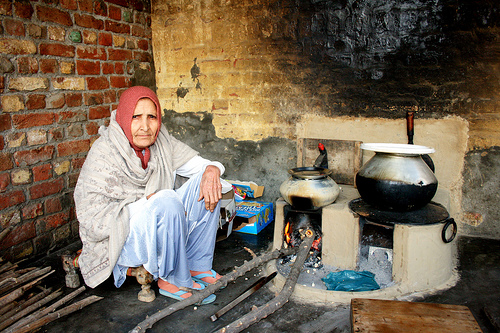
While driving home from a friend’s house one night I noticed something out of the corner of my eye as I passed the rows of darkened homes in his neighborhood. One garage door on the block was open and the garage lights were on, but there were no cars inside. Instead, there was an older Mata/Mai/Bibi/Bebe standing in front of a stove making roti, while a younger lady was dishing out what must have been some dal/sabzi.
The site was kinda cool and I had to resist the urge to stop my car and take a picture to post here – for fear of looking like a creepy weirdo. I did, however, think about it all the way home. What made it worth thinking about for a 10-minute drive is simple: it took me back to Punjab, where many farming families have two kitchens – one inside and one outside (where a bulk of the cooking is done).
Last year we heard the story of Lakhwinder Kahlon, a Delta, B.C. man who had been arrested for the murder of his two-year-old daughter, Rajwinder. This past week, Lakhwinder received an automatic life term when he pleaded guilty to second-degree murder. The father, who admitted to strangling and decapitating his daughter, will have to spend 11 years in jail before he can apply for parole. A few days ago, the judge released the 911 call of Lakhwinder admitting to the horrific act. The call is chilling – Lakhwinder tells the operator that he killed his daughter by cutting her neck, that he is depressed, and that the police should come and arrest him.
While it is hard to come up with any explanation to describe why Lakhwinder murdered his daughter, several suggestions were made. In an immediate reaction to hearing the news, there was speculation that Lakhwinder was upset that he only had daughters. This suggestion was vehemently denied by Lakhwinder’s wife and the community was quick to denounce female inequality.
Outrage and sorrow have poured out in radio talk shows and letters to newspapers, including one from Tara Diakow of Richmond, B.C., who wrote: “Who will battle against the ugly stereotype that Rajvinder Kahlon’s death has unfortunately brought to many people’s minds – the seemingly disposable position of Indo-Canadian women?” In a forceful statement on Monday, Liberal MP Ujjal Dosanjh used the case to denounce the practice of aborting female fetuses, which he says continues to take place in Canadian families. [link]
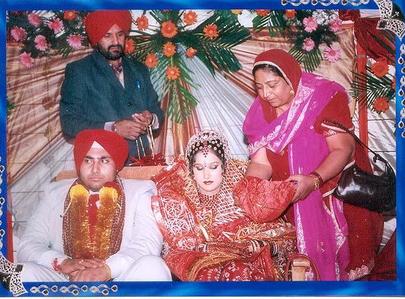
Pawandeep holds a framed photo of her sister. In the photo, Amandeep is wearing a pink salwar-kameez, a Punjabi dress. “She dreamed of a better life for herself and her family. All she wanted was to live happily with her husband and son like any other woman.”
I don’t even know where to begin with this story. The grisly facts of Amandeep Kaur Dhillon’s murder and her father-in-law’s arrest have been covered before, but this weekend, the Toronto Star’s Raveena Aulakh wrote a detailed story. You can read the full article here and it will break your heart, not just because of Amandeep Kaur’s tragic story, but because her story is all too common in our community.
Baldev Mutta knows the stories of immigrant women all too well.
The executive director of the Punjabi Community Health Centre in Brampton says hundreds of young Punjabi brides arrive in Canada every year. Many have arranged marriages. “They don’t know anyone, don’t have any support system and battle pressures most people can’t even imagine exist,” he said.
In the Punjabi culture, men are raised to be dominant while women are expected to be subservient. “The level of thinking of men in the Punjabi community leaves a lot to be desired,” said Mutta, a Punjabi himself. Mutta, who runs programs at four Sikh temples in Brampton, Rexdale, Malton and Oakville, and hosts a radio show, wishes he had been able to reach Amandeep.
Some women are so isolated that they are not allowed to have any communication even with their parents, said Kripa Sekhar, executive director of the South Asian Women’s Centre on Lansdowne Ave. in Toronto. “There are times when we get emails or phone calls from a woman’s family saying they haven’t heard from her ever since she came to Canada, can we check on her,” says Sekhar.In some cases women, bruised and beaten, have been locked up in their homes, not allowed to make or receive any calls. “It’s a problem women face everywhere, but what is unique among South Asians is that we don’t acknowledge it or want to talk about it.”
We can deny it all we want but here’s the sad reality for many (not all) Punjabi families:
(more…)
 This holiday season I noticed the pinched expressions on people’s faces, the emptier stores, the going out of business sales, and the general air of unease and uncertainty as we round out of the holiday season and into a worsening (economically) new year.
This holiday season I noticed the pinched expressions on people’s faces, the emptier stores, the going out of business sales, and the general air of unease and uncertainty as we round out of the holiday season and into a worsening (economically) new year.
Over the past few weeks, the NYT has been covering how the recession has impacted small businesses, which tend to operate under situations that make them more sensitive to the need for liquidity than larger corporations.
Even companies…, whose products and services are in demand, are being ensnared in the deepening recession…
Some 60 to 80 percent of new jobs [in the U.S.] come from small businesses, Mr. Keating said, and more than 50 percent of private sector gross domestic product is created by small business. [link]
The damage, however, is not just localized. As the slowdown in the U.S. economy drags other world economies down, slow times have also impacted small business owners in immigrant communities, including Vancouver’s Punjabi Market:
“I don’t see much of a future here,” said Virani, who is considering closing her shop.She isn’t alone. At least 10 storefronts between 48th and 51st avenues are papered over and displaying For Rent signs.
Hope all of you are enjoying your holidays with family and friends! Here is a “Punjabi” take on a Christmas and one of its infamous songs from my favorite British Comedy Show …. “Goodness Gracious Me”!
Some of you may have already seen it (GGM aired long ago, but is available on DVD-sets) … hope you have a great laugh after watching it!

UPDATE: If you are outraged by this incident, please CALL THE HARRIS COUNTY SHERIFF’S OFFICE (TEXAS) @ (713-755-6044) and let Harris County Sheriff Tommy Thomas know how you feel. These Officers need to be reprimanded and we as a community need to push the Sheriff’s Office to act. You can also contact Houston Mayor Bill White at (832-393-1000) or mayor@cityofhouston.net.
The night before Thanksgiving you are robbed of your sense of security and $15,000 of your home belongings AND THEN you are robbed of your humanity by Sheriff’s Officers who promise to protect you. All this happens in your own home …
The Tagore family in Texas were criminalized and terrorized because of their Sikh articles of faith after calling in to report a burglary in their home.
Ramandeep Singh Tagore says,
“That night we were actually robbed twice … Once by the actual burglars, who we don’t know who they were, and secondly by the Sheriff’s Department, who we knew who they were.”
Once the Sheriff’s Officers had arrived in their home they started focusing on Kawaljeet Kaur’s kirpan and told her: “You can’t wear that”, she felt like she was being treated “ … like a criminal in my own home … “. Kawaljeet Kaur [Ramandeep Singh Tagore’s sister] told the Houston News that “I didn’t appreciate the way that I was treated that day … I’m a human and I would have expected to be treated like a human.” Kawaljeet verbalized her feelings and constitutional right to practice her faith to the Officers. Their response was pushing her out of her house, having her sit in the middle of the street, and handcuffing her.
Ramandeep said to Harpreet Kaur of Sach Productions (watch the video below for more in-depth reporting)
“first we are calm and then the aggression … brutality type of thing … pushing and shoving is starting when the cops get here I mean their acting like thugs … if we are civilizingly dealing with them then why do you have to come push me and shove me when we’re trying to talk to you … is it because I look different or something.”
Manjit Kaur, Ramandeep’s mother, felt: “Dekhoo ik taan saade ghar robbery hoyi hai ..tusi lok saadi help karan aaye aan k saanu arrest karan aaye aan” (Look there has been a robbery in our house … have you people [Sheriff’s Officers] come to help us or arrest us?)
I know that we Punjabis love importing our culture and traditions to the countries we now call home, but this is getting ridiculous.
Brampton city councillor Vicky Dhillon is on a crusade to stop stores in his area from selling two kinds of decorative poppy flowers, which he said contain addictive opium.
Dhillon said the flowers and stalks are ground into a brownish powder — called doda — that is openly sold for about $10 for 10 grams at about eight meat stores in his Wards 9 and 10. The powder gets a person high when mixed with water and ingested, he said. “This drug is causing a lot of problems in the community,” said the councillor, adding it’s largely used in the Sikh and Hindu communities. His ridings contain more than 100,000 Sikhs.
Dhillon said he’s concerned the use of doda will spread to area schools due to its low cost. Peel Regional Police raided several businesses two weeks ago that were allegedly selling the drug. One man was arrested and 38 kilos of doda seized. Dhillon said he’s raised his concerns with Peel and Brampton city councils and health officials are looking into the problem.
Several varieties of poppies are allowed into Canada as decorative flowers, but only a few have a high opium content. Dhillon is calling for a ban on sales of two specific poppies — Arizona and Holland. “In the last two years, the use of doda has exploded,” he said yesterday. “This is a big threat to the younger people in our community.” Some of the stores selling the “ornamental flowers” were conducting brisk business yesterday. (Link)
I guess I should not be surprised. If drug use is at epidemic levels in Punjab, its naïve to assume people are going to magically clean up their act when the come to Canada. In fact, the culture shock, isolation and life changes that usually come with immigration, probably only make existing drug dependencies worse.
I was always amazed by the number of “meat shops” in Punjabi communities across Canada. I didn’t think there was enough demand for specialized Punjabi meat products to justify the supply. What I hadn’t taken into account was the “premium products” offered at the back of the store.
Often on this blog we have discussed what role our institutions should play in our lives and recently I had an opportunity to examine the issue anew. In a recent gurdwara council meeting I attended, one gurdwara decided to give a large sum of money to a group putting on a bhangra program. The group was not affiliated with the gurdwara. I will admit, I did not say anything at the time because I do not attend the gurdwara that decided to do this, but the incident did get me thinking about gurdwara funds and the concept of daswand.
When a gurdwara collects funds from the sangat – it does so under the pretence that the money is being collected to be put to some higher use, a use that we ourselves could perhaps not put it to, whether it be spiritual or practical. Usually we give the money as part of our daswand or some random seva to the gurdwara, but I think in every case it is understood that we are giving the money up to be put to a use that our Guru’s would have used it for – something necessary, something practical, and fundamentally “good.”
And as I write this post, some questions that I haven’t even answered for myself come to mind – Is the daswand I give to the gurdwara something I have a right to control – can I decide where it goes? If Sikhi is to be treated like a democracy, I would argue that absolutely I have every right to “vote” on where the funds go or at least have a chance to say something. But even in such a vote – should there be limits? Shouldn’t the funds of a gurdwara be spent on activities, which embody Sikh ideals and values? Presently, I am inclined to believe that sangat should have a say in where gurdwara funds are spent, but also that the options for spending funds should be limited to projects that actually embody and promote Sikh ideals.
But back to where we started – I brought bhangra up because it is something that can be debated – I’m not contending that it is an anti-Sikh activity, but at the same time, I don’t really think bhangra is something that perpetuates the Sikh way of life either. So I guess the dilemma in my mind in determining where the gurdwara should be spending its funds and where to draw the line…
In an effort to better understand the food habitats of Panjabi immigrants, Canadian researchers conducted a three-year study on the ingredients used in daily Panjabi meals and food choices made by Panjabi families.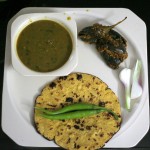
Gwen Chapman, study leader and British Columbia University nutrition professor, stated:
“Since cardiovascular diseases and type II diabetes are more prevalent among Indians and they are linked to food habits, we wanted to understand what ingredients went into daily Punjabi or Indian meals.”
An important part of study was also understanding how cultural affiliations play a role in Panjabi immigrant food choices.
Researchers found that “in Punjabi families in British Columbia … separate meals are often prepared to accommodate elders who need traditional roti, daal and subji, and younger family members who prefer to balance Indian and “Canadian” foods.”
While reading this article I thought about how these food choices actually play out in immigrant Panjabi homes across North America. I remember the rotis without butter for those who have high cholesterol and the weekend meal of burger and fries for us “American” kids. There were also the interesting “masalaa” pastas, lasagnas, and pizzas that had a “Panjabi” twist (i.e. tons of garam-masalaa). I recall uncles’ refusing to eat “kaa-foos” prepared by their wives, aunties making tofu-sabiji, and mothers’ substituting olive oil for vegetable oil when making tarkas. Many of these food choices were an effort to provide more healthy meals as a “preventive” form of action against heart disease and diabetes; while others were made to satisfy taste-buds.
So I was wondering what interesting food choices have you seen Panjabi families make in the Diaspora both to satisfy taste-buds and become more healthy?
Heads-up friends, the season of the “Spinning Wheel Festival” is about to begin across North America this autumn. Celebrating Sikh films and art, the first stop will be in New York City on Saturday, October 04, 2008 at the Asia Society & Museum (p.s. that’s next Saturday). Buy your tickets NOW! The wonderful Rabbi Shergill will be performing at the opening gala (yes I am really biased here … I heart Rabbi Shergill) and DJ Rekha will be literally “spinning” at the after party.
Films a the NYC festival will range from documentaries on Pahelwani (i.e. Panjabi wrestling) and Kaba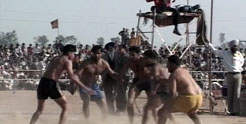 ddi-playing Canadian police officers to issues affecting the Sikh community from 1984 and post-9/11 hate crimes. There will also be short and feature films. For example, one on a young boy’
ddi-playing Canadian police officers to issues affecting the Sikh community from 1984 and post-9/11 hate crimes. There will also be short and feature films. For example, one on a young boy’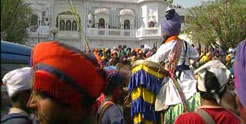 s struggle to keep his hair while his family fears the obstacles he will encounter and another on “… a young Sikh doctor struggling with the inequities of the American Health System and ultimately his own identity”. The Holy Duels of Hola Mohalla is a film looking at the Khalsa Panth.
s struggle to keep his hair while his family fears the obstacles he will encounter and another on “… a young Sikh doctor struggling with the inequities of the American Health System and ultimately his own identity”. The Holy Duels of Hola Mohalla is a film looking at the Khalsa Panth.
The films seem interesting both in content and presentation. The stories are grounded in the realities many of us encounter everyday. You can get a full listing of the films and their synopses here.
In the past, I have attended the “Spinning Wheel Festival” at one of its many North American stops and found it a great space for artists and art-enthusiasts to be exposed to Sikh creativity. I remember there being a panel discussion with the directors and the audience. We don’t have too many of these creative opportunities in our community even though we spend plenty of time and space advertising foreign medical schools in Poland, China, and the Caribbean.
I have found that some films are really hit or miss at these festivals, but it’s expected sense the focus is on cultivating and inspiring creativity; while, building a permanent Sikh film festival for years to come. Cash prizes are awarded to the “bests” in various categories. I have been told that the listing and quality of films varies across the different North American stops.
At the end of the day why not go, especially if it’s close by. I personally think it’s worth a visit as an act of supporting Sikh arts and learning about the various issues affecting our community. Sometimes we get too caught up in our own worlds and don’t realize these issues are taking place or we are in amidst of them and they become normal parts of our lives leaving very little room for reflection or exposure to others’ perceptions. Thus, it’s an 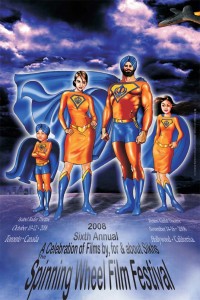 opportunity to get a fresh/new look at various issues.
opportunity to get a fresh/new look at various issues.
Lastly, the arts, from painting and photography to films and music, are our community’s soul! They help us speak in ways we can’t always articulate. So go save your soul and attend a Sikh artistic event! 
Okay, enough of the attempt at convincing … the other North American stops will be:
- Toronto, Canada from October 10-12, 2008 at the Isabel Bader Theatre.
- Hollywood, California from November 14-16, 2008 at the Writers Guild Theatre.
Are ya’ll thinking of going? What have your experiences been at the various Spinning Wheel Festivals? Does anyone know of other North American stops?
p.p.s. The Toronto and Hollywood poster is really interesting isn’t it … a conversation in of itself!
So recently I came across a blog about all the “Stuff Korean Moms Like”. A Korean girl, Chiyo, who loves her KM (Korean Mom) decided to create this blog “to share the joy and dread of KM”. As I went through the list … I kept thinking about our own PSM’s (Panjabi Sikh Moms) … now now don’t think it’s funny to call our mummies’ PMS that actually stands for Panjabi Male Syndrome!
As I went through the list … I kept thinking about our own PSM’s (Panjabi Sikh Moms) … now now don’t think it’s funny to call our mummies’ PMS that actually stands for Panjabi Male Syndrome!
From corningware to marrying people off and stank eye … I found many similarities between KMs and PSMs (although the differences were stark … I don’t even think many PSMs know what redbean is let alone love it. And when it comes to Jesus … let’s just stick with the Gurus and Waheguruji)!
Inspired by Chiyo’s blog on Korean Moms, let’ start our own list of “Stuff Panjabi Sikh Moms’ Like”! I will begin …
- Tupperware (i.e. I am not just talkin’ about Rubbermaid … I mean sour cream and whipped butter dabhaa). Over time this Tupperware becomes yellow from all the haldhee in sabjis … but soak it in the sun and most of the stains go away. Slowly over time old ones are replaced as new ones are collected.
- Corningware (do I really need say anything more … I think Chiyo’s explanation resonates perfectly with PSMs).
- Zee TV, Sony TV, and Alpha Etc. Punjabi nateekhs (what’s your mom’s favorite soap opera …).
- Noon Dhani (i.e. the steel container with small steel bowls and spoons for all their spices).
- Dhahee (i.e. homemade yogurt … sorry I personally can’t stand the boxed stuff after growing up on my mom’s delicious freshly made dhahee).
- Outrage at the rising cost of Ataa (i.e. flour that is commonly bought at the Indian store to make roti).
- House-walls that are painted hospital white … look how clean and simple they look. The rooms feel much more lighted with this color.
- Overstuffing Family And Friends With Food … lai if they leave your house without a food-coma, they did not have a good-time.
- Cooking your favorite Panjabi dish when you come home from college. It’s a sign of how much she missed you.
- The ten Gurus’ pictures, particularly those of Guru Nanak Dev Ji and Guru Gobind Singh Ji, are the number one home-decorating items.
Please add to the list ( it’s in no particular order)! What do you think Panjabi Sikh Mom’s really like? I know many of you must have your own favorites! 
Disclaimer: Please keep it clean, respectful, and hate-free … I really should not have to say this, but unfortunately in the virtual world people often display a “holds-no-bar” attitude when commenting on issues like this one.
